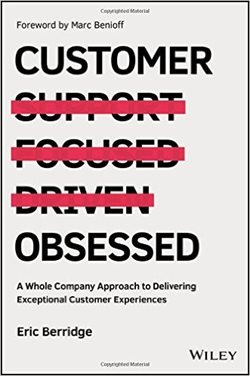Getting Customer Obsessed with Bluewolf's Eric Berridge
 Eric Berridge, CEO of Bluewolf, an IBM Company, has a new book out called Customer Obsessed. I could not pass up an opportunity to read a book that looks at how organizations need to blend people, culture, and technology to create exceptional customer experiences. I've not finished the book yet, but I did get an opportunity to talk with Berridge about some of his ideas.
Eric Berridge, CEO of Bluewolf, an IBM Company, has a new book out called Customer Obsessed. I could not pass up an opportunity to read a book that looks at how organizations need to blend people, culture, and technology to create exceptional customer experiences. I've not finished the book yet, but I did get an opportunity to talk with Berridge about some of his ideas.
It’s Not Just About Heroic Moments
There is so much discussion about supporting the big customer moments as if being there for those were the only thing that mattered. Berridge said it’s not just about those heroic moments. It’s about every moment.
So how does a company switch to thinking and supporting “every moment?” Berridge said it’s a shift that takes a whole company approach. It’s understanding that your culture and your employees' level of engagement is as important as the underlying technology that drives customer experience.
What does that mean? He said you have to acknowledge that your customer experience is led with digital. Your customer is a number in a database, and that is how you know them. That means your customer experience is only going to be as good as your data.
Those big moments? That’s usually when something has gone wrong. You usually get notified of these moments pretty quickly, but your data helps you understand specific moments your customer has with your brand at a finite level. Knowing all those moments can help you build better experiences all the time.
Put the Customer at the Center of Your Tech Platform
Most organizations have an accounting or ERP application or product at the center of their technology. That puts products at the center. Berridge said to get to a state where you can manage every custom moment, you have to put the customer at the center. Then you use digital technologies to engage employees so they can easily know what is going on with the customer and where that customer is in their journey. This enables you to align your products and services around the journey. His big note - “Don’t try to align the customer around your products and services.” Think Uber, Netflix, and Amazon.
Data is Critical
“We believe that data and specifically consumer data is a currency that is going to become way more valuable over the next few years.”
According to Berridge, we are moving into an era where a certain amount of trust is needed between the customer and the brand. Customers will realize that if they don’t give their data, the brand won’t survive. But they will need to know what they are getting in return, and that’s a great customer experience.
He gave Detroit as a good example. The US automobile industry is evolving. It is less focused on the car itself (the product) and more focused on the experience - “what does it feel like when I am driving this car, how good is the technology in it, how am I helping an individual get from point A to point B?”
Consider GM. GM doesn’t consider itself a car company, it considers itself a transportation company. Their thinking is to make the journey easier, faster and cheaper. And they need data about the customer to build that experience.
How complicated is it to capture all of this needed data? After all, much of it is siloed and some of it is dirty or not relevant. And there is so much of it. Berridge said we must move toward cognitive computing and AI. Cognitive computing is the ability to consume massive amounts of unstructured data and make sense of it. For example, IBM Watson is designed to consume unstructured information and learn about that information, making assumptions and inferences.
The reality is organizations have to figure out how to leverage unstructured data. It’s impossible to categorize much of the data ingested today using relational structures. A cognitive platform will help you make sense of the information so you can use it to drive great customer experiences.
Watson isn’t the only technology like this. There are others like Salesforce’s Einstein and Attivio’s semantic data catalog. But before you get worked up about the technology, Berridge said you first need to think about the customer journey. He suggested doing a mapping exercise and thinking about things from the perspective of the customer journey. Then you’ll see how your product fits in. He also said the data will tell you what your customers are doing and understanding that journey at a deeper level will help you figure out how to facilitate the journey.
The Acquisition vs. Retention Question
Berridge told me that retention as a business outcome is easier from the technology perspective because you have more relevant data about your customers than you do about prospects. He mentioned AmerisourceBergen, one of the largest pharmaceutical companies in the world. He said they make over 50,000 deliveries a day - think about the data they collect on a daily basis. This company has no choice but to use cognitive computing to make sense of all their customer data and make educated decisions on the state of their customers.
It’s the data that makes retention as a business outcome quantifiable. You know what your customers spend, how long they’ve been with you, what products they buy, and so on, so it’s much easier to justify the ROI than it is for acquisition programs. That also means there’s no excuse to not be good at it.
Giving Employees Freedom to Support Customers
Another big topic of discussion is how you give employees the freedom they need to properly support customers. Berridge said there’s a balance you have to create between staying in control of the types of conversions and activities that happen with customers and ensuring your employees are engaged and feel like they are delivering great experiences.
But Berridge said that before you start getting concerned about the type of freedom you give employees, you need to provide them with systems that are simple to use, intuitive and prescriptive. When everything is hidden in spreadsheets on desktops, when employees aren’t connected to information, that’s when they tend to make things up, make concessions, Berridge said they don’t have the information or collaboration needed to properly position products in the customer’s journey. If you want control over the message and how your employees engage, then you have to invest in the technology.
“Employees are getting smarter all the time. But a lot of the technology inside a company hasn’t changed. Match the evolution of your employee with the evolution of your technology to create engagement and get more control.”
Berridge’s Best Advice
Berridge laughed when I asked this one because, after all, that’s what the book is - his best advice. How do you distil it down into one thing? So I asked him what the starting point should be.
His answer was an old fashioned piece of advice “get your customers together and allow them to collaborate.”
He said if you’re in business today, you’ve already figured out the hardest part - how to engage the customer. But if you aren’t constantly trying to figure out how to make the experience better, then Berridge said you won’t survive.
The best way to figure that out is to let your customer collaborate. This is something social has enabled by the way. Ultimately, Berridge said, the collaboration process sheds the most light on what the customer experience and journey needs to be - inside and outside of the organization.
You can read more about Berridge’s ideas on customer experience by reading his book: Customer Obsessed. I know I’m learning more every chapter I get through, and it’s written in a way that makes you want to keep reading.

Barb Mosher Zinck
Barb Mosher Zinck is a content marketer, marketing technology analyst. She spends her days learning how to build better customer experiences through content, translating what she’s learned into actionable strategies for her clients and practical guidance for her magazine audience.